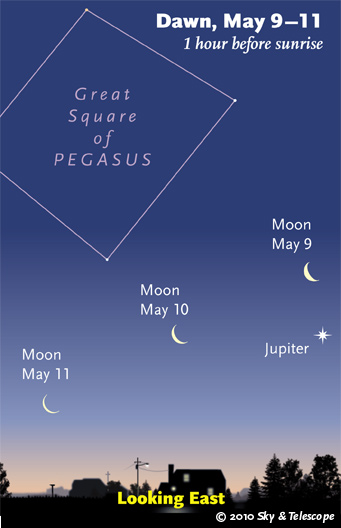
At dawn, Jupiter and the waning Moon highlight the low eastern sky. (These scenes are drawn for the middle of North America. European observers: move each Moon symbol a quarter of the way toward the one for the previous date.)
Sky & Telescope diagram
Friday, May 7
Saturday, May 8
Sunday, May 9
Monday, May 10
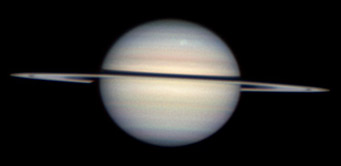
As of May 10th the Saturn Electrostatic Disturbance (SED) white spot was back yet again. This ammonia-blizzard thunderstorm is a very difficult eyeball sighting even in a large amateur telescope, but amateur stacked-video imagery like this is showing it again plainly. Amateurs have been creating a good record of the SED's brightenings and dispersals in the last few months.
South is up in this image taken May 10, 2010, at 11:21 UT, by Anthony Wesley in Australia. Click for his full-size images. The System III central-meridian longitude was 51°. The spot has been moving nearly 1° per day toward increasing System III longitudes since amateurs began imaging it two months ago.
Tuesday, May 11
Brighter Arcturus shines high in the southeast. Below Saturn and Arcturus you'll find Spica. Look lower right of Spica for the four-star pattern of Corvus, the Crow.
Wednesday, May 12
Thursday, May 13
Friday, May 14
Saturday, May 15
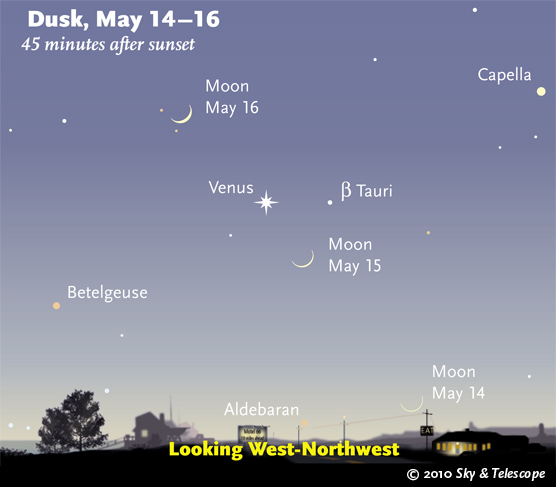
The Moon passes Venus when it returns to the evening sky. (The visibility of faint objects in bright twilight is exaggerated here.)
Sky & Telescope diagram
.
.
Want to become a better amateur astronomer? Learn your way around the constellations. They're the key to locating everything fainter and deeper to hunt with binoculars or a telescope.
Sky Atlas 2000.0 (the color Deluxe Edition is shown here) plots 81,312 stars to magnitude 8.5. That includes most of the stars that you can see in a good finderscope, and typically one or two stars that will fall within a 50× telescope's field of view wherever you point. About 2,700 deep-sky objects to hunt are plotted among the stars.
Alan MacRobert
For an easy-to-use constellation guide covering the whole evening sky, use the big monthly map in the center of each issue of Sky & Telescope, the essential magazine of astronomy. Or download our free Getting Started in Astronomy booklet (which only has bimonthly maps).
Once you get a telescope, to put it to good use you must have a detailed, large-scale sky atlas (set of charts). The standards are the Pocket Sky Atlas, which shows stars to magnitude 7.6; the larger Sky Atlas 2000.0 (stars to magnitude 8.5); and the even larger and deeper Uranometria 2000.0 (stars to magnitude 9.75). And read how to use your charts effectively.
You'll also want a good deep-sky guidebook, such as Sky Atlas 2000.0 Companion by Strong and Sinnott, or the more detailed and descriptive Night Sky Observer's Guide by Kepple and Sanner or the classic if dated Burnham's Celestial Handbook.
Can a computerized telescope take their place? I don't think so — not for beginners, anyway, and especially not on mounts that are less than top-quality mechanically. As Terence Dickinson and Alan Dyer say in their Backyard Astronomer's Guide, "A full appreciation of the universe cannot come without developing the skills to find things in the sky and understanding how the sky works. This knowledge comes only by spending time under the stars with star maps in hand."
This Week's Planet Roundup
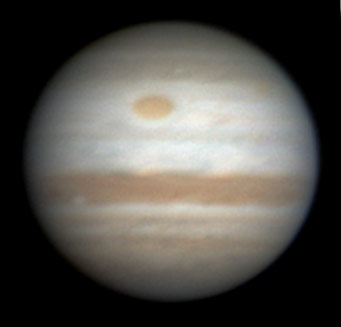
Jupiter's dark North Equatorial Belt is currently wide and massive, in contrast to the almost nonexistent South Equatorial Belt — whose absence leaves the Great Red Spot floating free in whiteness. Note too "Red Spot Junior" (Oval BA) adding a trace of color near the upper right limb. South is up.
Christopher Go in the Philippines took this image on May 6th at 20:42 UT, when the central-meridian longitude was 156° (System II). The Great Red Spot is near System II longitude 150°. Assuming it stays there, here's a list to print out of all the Great Red Spot's predicted transit times for the rest of 2010.
Mercury is hidden deep in the glow of sunrise.
Venus (magnitude –3.9, in eastern Taurus) shines bright and steady as the Evening Star in the west-northwest during and after twilight. Capella is the bright star far to its upper right. This week, Venus is near Taurus's horn-tips: Beta and Zeta Tauri. Watch each night as Venus approaches them and then passes midway between them on the evening of May 14th.
Mars, dimming farther into the distance at magnitude +0.9, is in Cancer high in the west during evening. It's just past eastern quadrature. Upper left of it are Regulus and, above Regulus, Gamma Leonis. Watch Mars closing in on Regulus during the next few weeks. They'll be closest on June 6th, 0.8° apart.
In a telescope Mars is a tiny blob, 6.8 arcseconds in diameter. Can you still make out its gibbous shape? Mars is as gibbous as it will appear all year: only 90% of its diameter is sunlit. The summer solstice in Mars's northern hemisphere is on May 12th, so the north polar ice cap has shrunk out of visibility in most scopes.
Jupiter (magnitude –2.2, below the Circlet of Pisces) shines low in the east in early dawn. Nothing else there is nearly so bright!
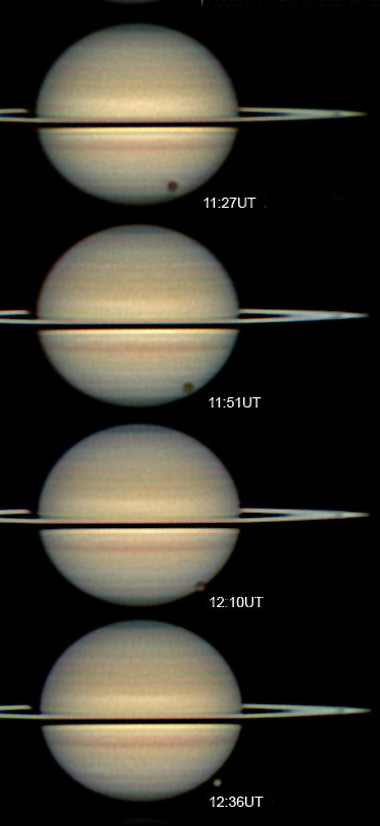
Titan and its shadow were leaving Saturn's face when Christopher Go in the Philippines took these shots on May 1, 2010. North is up. Click image for video of the transit.
Four more Titan transits are coming up, all visible from the Pacific. Lasting up to a few hours, they are centered on May 17 at 8.6 hours UT; June 2, 7.2h UT; June 18, 6.2h UT; and July 4, 5.5h UT.
Also in these images, note the dark reddish South Equatorial Belt, the wide, bright Equatorial Zone — and the striking black line of the rings' shadow on the globe. We see the shadow because, on the date of the pictures, the rings were tilted 1.9° to Earth's line of sight but 4.0° to the incoming sunlight. This disparity allows us to see the rings' shadow on the globe. This situation began in mid-March and has increased since then, making the shadow-line grow wider and more prominent.
Alan MacRobert
Saturn (magnitude +0.9, in the head of Virgo) is high in the south during evening. In a telescope Saturn's rings are tilted a mere 1.8° from edge-on. They'll stay essentially this narrow for the next month, the minimum tilt they'll have for some 15 years to come. Note the thin black shadow-line that they cast on Saturn's disk! Now is also a good time to try for the more difficult of Saturn's moons with your telescope; see the May Sky & Telescope, page 61.
Uranus (magnitude 5.9, in Pisces) is in the background of Jupiter at the crack of dawn.
Neptune (magnitude 7.9, at the Aquarius-Capricornus border) is in view just before dawn well to Jupiter's west. See our finder charts for Uranus and Neptune in 2010.
Neptune is at a historic milestone this season. For the first time since it was discovered in 1846, Neptune has completed a full circuit of the sky and has returned very close to the point where Johann Galle first spotted it from Berlin Observatory on September 23rd of that year — following a prediction by Urbain Le Verrier in France that a new planet ought to be there, based on gravitational perturbations of Uranus. See The Return of Neptune. (The joint credit usually given to John C. Adams in England for the prediction turns out to be mostly unjustified; see Secret Documents Rewrite the Discovery of Neptune.)
Pluto (magnitude 14, in northwestern Sagittarius) is highest in the south before dawn. See our Pluto finder charts for 2010.
All descriptions that relate to your horizon or zenith — including the words up, down, right, and left — are written for the world's mid-northern latitudes. Descriptions that also depend on longitude (mainly Moon positions) are for North America. Eastern Daylight Time (EDT) equals Universal Time (also known as UT, UTC, or GMT) minus 4 hours.
To be sure to get the current Sky at a Glance, bookmark this URL:
http://SkyandTelescope.com/observing/ataglance?1=1
If pictures fail to load, refresh the page. If they still fail to load, change the 1 at the end of the URL to any other character and try again.
 0
0
Comments
You must be logged in to post a comment.